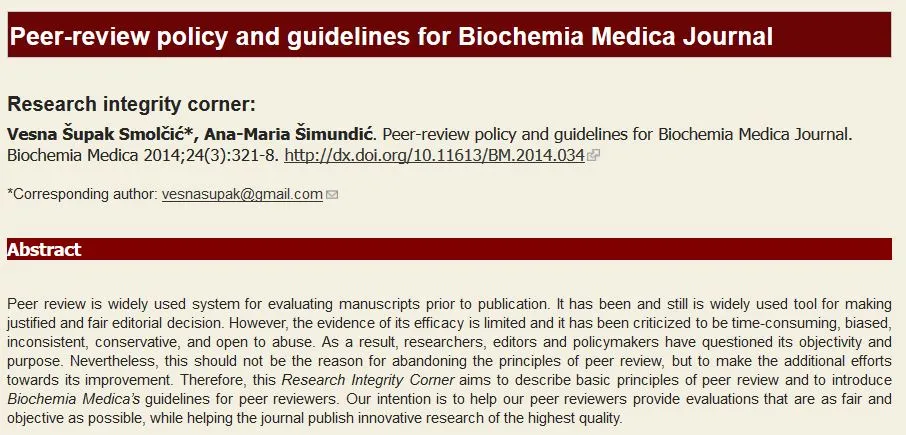How to be a good peer reviewer
Neeraja Sankaran, Ph.D. | Jan. 17, 2018An invitation to be a peer reviewer, whether for a journal article or a book manuscript, is both an honor and responsibility and should never be undertaken without careful consideration.
It is an honor because the fact that you have been asked to undertake this task means that someone—the publisher, editor, or some other colleague in the field—thinks highly enough of your work and judgement to entrust you with the task of evaluating someone else’s research and writing.
So, what is peer review?
As the uncle of young Peter Parker warned the future Spiderman (as played by Toby Maguire): “With great power, comes great responsibility.”

Your power in the role of a peer reviewer lies in determining whether or not another researcher’s work will be published , and your responsibility, to quote the editors of the Croatian journal Biochemia Medica , is, in a nutshell, to
“analyze the manuscript objectively and thoroughly and to provide useful advice and constructive comments to the author.”
As a published author of several academic papers, I can certainly attest to the tremendous usefulness of a well executed peer review, even in the disappointing occasion of a rejection. (Eventually I did get the paper that was rejected published in a different journal but not before I had incorporated the very valuable advice of those anonymous peer reviewers.)
In light of my experiences at the receiving end of the peer review process, I have always tried to return the favor to my research community. As far as possible, I accept peer review assignments and then, having committed to an assignment, strive to complete it properly in a timely fashion.
In this article, I offer some tips on being a good peer reviewer. It is not, by any means, a comprehensive guide (although we hope to provide a more comprehensive guide in the future).
Receive Free Grammar and Publishing Tips via Email
I heartily recommend the afore-quoted Biochemia Medica article in which the editors offered a detailed breakdown of the elements of criticism they would like to receive from their reviewers.
Here, I merely offer insights gleaned from my own experiences reviewing scholarly articles for a few different peer reviewed journals.
I have focused on journal articles because some of the considerations in peer-reviewing book manuscripts are a little different, and more—though certainly not exclusively—the province of the humanities and social sciences (the "book-heavy disciplines") than of the sciences. But for the most part, the considerations below would apply to all types of academic peer review.
1. Considering an invitation to peer review
Whether or not to accept a peer review assignment is not a decision you should take lightly. Some factors to consider as you make your decision include the following:
Expertise/specialization:
Just a quick look at the title and abstract should give you a sense of whether or not you are the right reviewer for the article. You may not be an expert in all its aspects; but, if the journal’s editors have done their homework, chances are there will be a significant intersection between the paper’s subject and your specialized field of knowledge. If not, you should turn it down.
In these days of high-speed internet and open access, there has been a flood of new journals that are rushing to publish research articles. Personally, I am wary of invitations from such journals —many seem to have been issued based on very vague criteria. If you feel uncomfortable about the invitation, you should refuse.
Time:
The time factor is a difficult one to judge because almost every one of us feels like we could do with more time—to finish experiments, write our own papers and other myriad day-to-day activities. On the flip side, there is the issue of good citizenship in your research community, and then there is always the possibility of that personality flaw which does not allow you to say no.
My rule of thumb is that if you have 3–5 days in the upcoming month in which you can dedicate a few hours to reading and reviewing a paper (books need a lot more time, 3–6 months), then you should consider taking it on.
If you do not think you can can complete the task by the end of 3 weeks to a month, my advice is to turn the invitation down as soon as possible.
Of course, you are not obligated to undertake a peer-review task by any means. But, if you decide not to, please do give the editors the courtesy of an explanation as soon as possible.
2. Academic dishonesty
This issue is not a pleasant one to talk about because we are talking about peers, i.e., colleagues, whom I would like to believe I can trust. But certainly no one should be exempt from a check. If the authors are honest, they have nothing to worry about.
Some of the tips I offered in a previous article about writing and citation practices that raise red flags might be useful in guarding against accepting plagiarized work. Of course, if you detect plagiarism, you should say so in your peer review and reject the paper.
Not being a scientist, I have no advice to offer on detecting the falsification of data; presumably data that sounds too good to be true could be double checked in your own lab if you are in the same field and have the same equipment.
3. Preliminary steps to peer reviewing
Before plunging into reading the article in depth, here are a couple of steps to orient yourself:
- Remind or familiarize yourself with details, such as the aims, scope, and intended audience of the journal you have been invited to peer review for. If it is your first interaction with the journal, then read a few recent peer reviewed articles or at least the journal’s scope and information for authors offered on their website.
-
Take a quick look at the
title of the article
. Does it give you a clear sense of what the content might be? The title should also be free of jargon or specialized language and offer suggestions for improvement but resist the temptation to "show off" or superimpose your style on that of the author.
Receive Free Grammar and Publishing Tips via Email
4. Co ntent review
Remember, the main task of a peer reviewer is to evaluate the substance of an article and decide whether or not you think it will add some new and/or useful knowledge or perspectives to your discipline.
While such issues as usefulness are subjective, here are a few tangible points to consider that might make your decision more thoughtful and transparent:
i). Make sure that the article delivers what the abstract promises . It may help to have a copy of the abstract beside you and check off each detail as it is covered in the body of the article. In your commentary (or letter to the journal editor), make a list of any gaps in the correspondence between the abstract and the article itself.
ii). I always find it useful to take an early look at the bibliography to make sure that it is adequate, relevant, reliable, up-to-date on the literature and not overly weighted.
iii). As you are reading the article, identify any major omissions in the citation of literature. In your commentary, offer recommendations for addressing these gaps. Check out my previous article on citation of sources for more details.
While on the issue of citation, I will confess that as a peer reviewer, I do not worry about such issues as consistency in citation style . Matters of style can and should be attended to by the copy editors of the journal.
iv). Do the data and arguments back up claims adequately? If not, why not? Identify holes in the argument and offer suggestions to address the gaps.
v). As a peer reviewer, you are not obliged to copy edit the article, although you may wish to point out parts that are difficult to understand. You may, however, suggest that the author have the article professionally edited if the article requires it.
5. Rendering a decision
-
Rarely will you find a research paper worth accepting as is and render a straight “
Accept
” decision. If you do, good for you and, even better for the author!
- If you have done your job properly, you would have invariably detected at least some small issues that you wish to have corrected. The verdict in that case is typically “ Accept with minor revisions ,” which is the most likely—and helpful—favorable decision. Typically your involvement with the process ends at this stage.
- If you feel that the paper has something to say but does not do it properly, it does not offer sufficient evidence, or it requires major rewriting, then the verdict should be an “ Accept with major revisions ”, often labelled by some journals as “ Revise and resubmit .” In such cases, the journal editor may send the rewritten article (authors are usually given a time limit) back to you for a second round of peer review.
- The dreaded “Reject ” verdict is harder to render than you might think. At least it has been for me, but if the article has failed to meet standards in more ways than one, then alas, you have to recommend rejecting it.
In some cases, it is possible that the article does not match well with the journal. Such a mismatch actually happened to me once. Very kindly, the editors immediately suggested their sister journal, which was more appropriate, and the paper was “accepted with minor revisions” in that journal.
So as a grateful beneficiary of such treatment, I would urge peer reviewers to offer suggestions for alternative peer reviewed journals if they can think of appropriate ones.
In case of any plagiarism or other detectable forms of dishonesty, however, the manuscript should be unequivocally rejected.
I wish you a fruitful and good experience with peer reviewing!
Do you have your own experiences as a peer reviewer? Share with us your experiences.
Other articles that may interest you:
Tips for International Authors Who Wish to Publish in English Language Journals
The Importance (or Not) of Writing in English in the Scholarly Context
Essentials for Giving a Memorable Keynote Presentation
Comments or Suggestions?
Complete our Blog Feedback Survey and Receive 10% Off Your Next Editing or Translation Order!
For further reading:
Šupak Smolčić, Vesna, and Ana-Maria Šimundić. “ Peer-Review Policy and Guidelines for Biochemia Medica Journal .” Biochemia Medica 24, no. 3 (2014): 321–28. doi:10.11613/BM.2014.034.
Baker, Dale. “ The Peer Review Process in Science Education Journals .” Research in Science Education 32, no. 2 (2002): 171–180.
About the Author:
Neeraja Sankaran is a historian of science (Ph.D., Yale University, 2006) specializing in the recent history of biological and biomedical research. She came to this field with a background and experience in science writing (Grad. certificate, 1993) and microbiology (M.Sc., 1990). Author of two general reference-style books on the topics of micro-organisms and the human genome as well as numerous articles on science and scientists for general audiences, she has also published a number of papers in peer-reviewed academic journals on various aspects of the history of biology and medicine, including but not limited to, virus research, immunology, and origin-of-life theorizing. She is currently an independent scholar working on a scholarly monograph that is expected to be published in 2018 by the University of Pittsburgh Press.
Topics : Peer review


